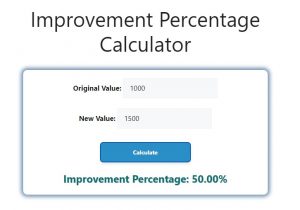About Improvement Percentage Calculator (Formula)
An Improvement Percentage Calculator is a valuable tool used to measure the progress or enhancement of a specific value over time. Whether you’re assessing the effectiveness of a project, tracking personal growth, or analyzing business performance, knowing the percentage of improvement can provide significant insights. This calculator allows you to quantify the changes between an old value and a new value, helping to visualize progress and make informed decisions.
Formula
The formula to calculate the improvement percentage is:
Improvement Percentage equals ((New Value – Old Value) divided by Old Value) multiplied by 100.
Where:
- New Value is the updated or current value after improvement.
- Old Value is the initial or previous value before improvement.
How to Use
- Determine Values: Identify the old value (the initial figure) and the new value (the updated figure).
- Input Values into the Formula: Subtract the old value from the new value to find the difference.
- Divide by Old Value: Take the difference and divide it by the old value.
- Multiply by 100: Finally, multiply the result by 100 to convert it into a percentage.
- Interpret the Result: The final result represents the percentage of improvement.
Example
Imagine you have a sales figure of $1,000 last year (Old Value) and this year, it increased to $1,500 (New Value).
Using the formula:
Improvement Percentage = ((1,500 – 1,000) / 1,000) * 100
Improvement Percentage = (500 / 1,000) * 100
Improvement Percentage = 0.5 * 100
Improvement Percentage = 50%
This indicates that there has been a 50% improvement in sales.

FAQs
1. What is an improvement percentage?
An improvement percentage measures the change in value over time, expressed as a percentage of the original value.
2. Why is it important to calculate improvement percentage?
Calculating improvement percentage helps assess progress, make informed decisions, and evaluate the effectiveness of changes implemented.
3. Can the improvement percentage be negative?
Yes, if the new value is less than the old value, the improvement percentage will be negative, indicating a decline.
4. What is the formula for improvement percentage?
The formula is: Improvement Percentage = ((New Value – Old Value) / Old Value) * 100.
5. How do I interpret a 100% improvement percentage?
A 100% improvement means that the new value is double the old value.
6. Is this calculator useful for business performance analysis?
Yes, it is commonly used in business to track performance improvements, sales growth, and productivity enhancements.
7. How do I calculate improvement if the old value is zero?
If the old value is zero, calculating improvement percentage can be problematic, as division by zero is undefined. In such cases, it is more informative to just note the new value.
8. Can I use the improvement percentage calculator for personal goals?
Absolutely! You can use it to track personal growth in various areas such as fitness, finance, or education.
9. Is there a minimum or maximum value for old and new values?
There are no strict limits, but values should be meaningful and contextually relevant to what you are measuring.
10. How can I calculate improvement percentage for multiple values?
You can calculate the improvement percentage for each pair of old and new values individually and then find an average if needed.
11. What if I want to compare multiple improvements?
You can calculate the improvement percentage for each change and then analyze them separately to see which has the highest percentage.
12. Can this calculator be used in academic settings?
Yes, it can be used in educational settings to track improvements in grades, attendance, or other measurable outcomes.
13. How does improvement percentage relate to performance metrics?
Improvement percentage provides a straightforward way to evaluate performance metrics, making it easier to identify successful strategies or areas needing attention.
14. What is a practical example of using this calculator?
A practical example is calculating the percentage increase in customer satisfaction scores after implementing a new service strategy.
15. How does improvement percentage affect decision-making?
Understanding improvement percentages can guide decisions about resource allocation, strategy adjustments, and future goals.
16. Can I use the calculator for non-numerical data?
The improvement percentage calculator is primarily for numerical data. For qualitative data, other methods may be more appropriate.
17. What if my improvement percentage is below 0%?
An improvement percentage below 0% indicates a decrease in value, which may require analyzing the reasons for the decline.
18. How can I communicate improvement percentage to stakeholders?
Presenting improvement percentages in reports or presentations can help stakeholders quickly understand the impact of changes made.
19. Can I use this calculator for budgeting?
Yes, it can be used to analyze changes in budget allocations, expenses, or savings over time.
20. Is there software available for calculating improvement percentages?
Many spreadsheet programs, such as Microsoft Excel or Google Sheets, can perform these calculations easily.
Conclusion
The Improvement Percentage Calculator is a simple yet powerful tool for quantifying progress across various contexts, from business performance to personal goals. By using the formula to calculate the improvement percentage, individuals and organizations can effectively measure their achievements and make data-driven decisions. Understanding how to interpret and apply improvement percentages can lead to greater insight and continuous improvement over time.